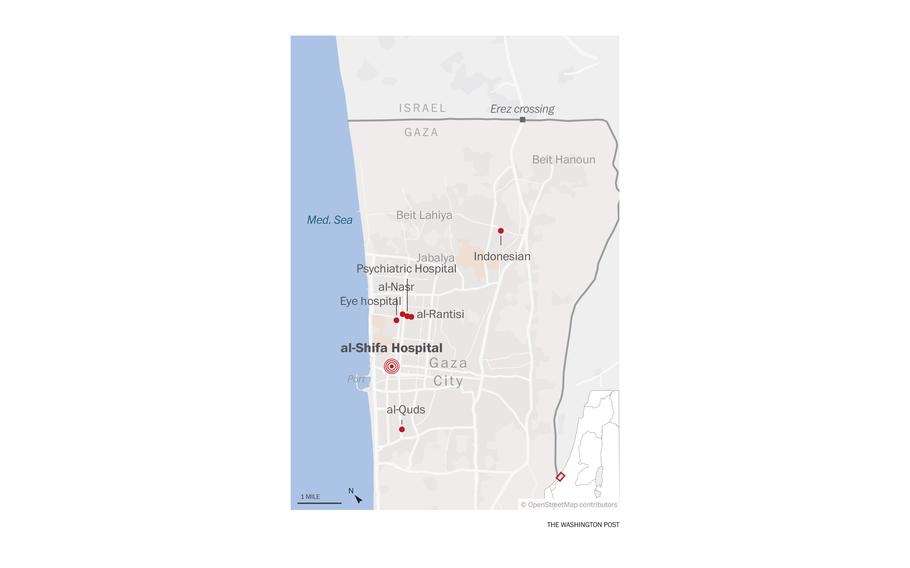Middle East
AnalysisWhat to know about Gaza’s al-Shifa Hospital
The Washington Post November 16, 2023

()
Israeli forces conducted a raid Wednesday on the besieged al-Shifa Hospital complex in Gaza City, which is housing some 700 patients, 400 health workers and 3,000 displaced people, according to U.N. figures. Israel’s military operations were still ongoing at the hospital on Thursday, Israeli officials and Gaza’s Health Ministry said.
Heavy combat has raged around hospitals in Gaza for several days, halting ambulances and further stressing a beleaguered health-care system that is rapidly running out of fuel and the capacity to treat patients. Dozens of patients at al-Shifa Hospital have died in recent days, Gaza Health Ministry officials said, and bodies have piled up around the hospital complex.
Israel has repeatedly said that Hamas has a command center under the hospital. The United States has also asserted that Hamas is using hospitals, including al-Shifa, and the tunnels underneath them for its military operations. Doctors, first aid responders and the few aid workers left in the area have denied giving cover to militants and said the raid is an attack on civilians.
Here is what to know about Gaza’s largest hospital.
Where is al-Shifa Hospital, and who built it?
Al-Shifa, which means “healing” in Arabic, was built in 1946 during British rule and was revamped in the 1980s, according to Reuters. The hospital has about 800 patient beds.
The 45,000-square-meter hospital complex is in a densely populated part of Gaza City near al-Shifa Mosque.
Mohamed Abu Salmiya, director of al-Shifa Hospital’s medical complex, said Friday that “medical teams will not leave the hospital and will not abandon the patients inside of it.” He told Al Jazeera that only critical departments, including intensive care, the neonatal and dialysis units, and the operating theater, were still operating.
The hospital’s critical functions, including ventilators, incubators and intensive care unit equipment, have been at risk of shutting down because of a lack of fuel, the World Health Organization said Sunday.
What do we know about the Israeli raid on the hospital?
The Israeli military said around 2 a.m. local time Wednesday that it had begun what it called a “precise and targeted operation against Hamas” at al-Shifa Hospital, Gaza’s largest medical center. About 18 hours after the Israel Defense Forces first warned of the raid, the military said the operation was still underway.
According to the United Nations, about 700 patients were present at the hospital during the raid, as well as more than 400 medical workers and about 3,000 displaced people seeking refuge.
Munir al-Bursh, general director of hospitals in Gaza, told The Washington Post by phone around 7 p.m. Wednesday local time that Israeli “tanks retreated to around the hospital but that soldiers remained in the hospital. Gaza Health Ministry spokesman Ashraf al-Qudra said operations were still ongoing on Thursday. Soldiers searched and took about 100 dead bodies that had accumulated on the premises, he said.
Details of the raid remain murky because of communications outages, Israeli bombardments and ground fighting.
Israel says Hamas is using the hospital’s staff and patients as a shield - a claim Hamas and medical workers at the hospital have denied. An IDF statement said troops “encountered explosives and terrorist squads” in the fight to enter the compound. A military-run news outlet said troops searching the facility had so far not found any sign of hostages on-site.
White House National Security Council spokesman John Kirby backed Israel’s assertions Tuesday. “We have information that Hamas and the Palestinian Islamic Jihad used some hospitals in the Gaza Strip, including al-Shifa, and tunnels underneath them, to conceal and support their military operations and hold hostages,” he said.
The Israeli military released two videos and a few photos Wednesday from the hospital showing what it said were Hamas weapons and other gear recovered from the complex. The full alleged haul included 11 guns, three military vests and nine grenades, among other things. The Washington Post was unable to independently verify who the weapons belonged to or how they came to be inside the hospital’s radiology unit.
Gaza Health Ministry spokesman Ashraf al-Qudra told The Post from al-Shifa that the Israeli military “contacted the Ministry of Health administration and said they would storm the hospital.” He said only civilians were at al-Shifa and rejected claims to the contrary.
Projectiles landed inside the hospital complex in recent days. On Friday, at least six hospitals in Gaza City reported being under siege or close to heavy urban combat.
Bursh said by phone Saturday that dozens of bodies were in the hospital’s courtyard but that they could not be buried because of bombardments.
What is happening to medical care in Gaza?
More than half of the hospitals in Gaza are no longer functional because of damage and attacks, according to the WHO. As of Tuesday, only one hospital in northern Gaza, al-Ahli Hospital in Gaza City, was able to admit new patients, according to the U.N. Office for the Coordination of Humanitarian Affairs.
Gaza’s Health Ministry has been unable to release an updated death toll since Friday, its spokesman said in a phone call Tuesday, citing extended internet cuts and a loss of communication with hospitals in the enclave. The ministry says the toll is more than 11,100, but it could not release an exact number.
Medhat Abbas, spokesman for the Gaza Health Ministry, said Monday that at least 100 bodies were decomposing in the hospital complex, with about 50 inside the hospital and dozens more in morgues that have run out of power. Staffers began preparing a mass grave, OCHA wrote in a news release Tuesday.
Limited fuel and supplies have forced some hospital departments to shut down, with surgeons forced to operate on patients without anesthesia. Israel began blocking all fuel from entering Gaza shortly after Hamas’s Oct. 7 attack, and only a small fraction of the aid convoys needed have entered the enclave.